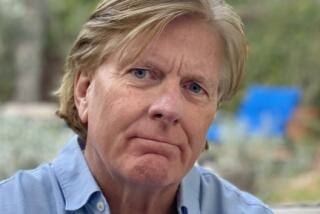Covers Persian Gulf Incident During Study of Foreign Correspondents : CSUN Journalism Professor Becomes a Subject of His Own Research
- Share via
A San Fernando Valley journalism professor doing research on foreign correspondents in “hot spots” worldwide suddenly found himself thrust into the role of reporter in the tension-filled Persian Gulf on Thanksgiving Day.
Michael Emery, chairman of the journalism department at California State University, Northridge was monitoring television crews in the Persian Gulf on a short-wave radio when an Iranian frigate fired on a Kuwaiti oil tanker posing as a Romanian vessel.
“I heard the voice of an Iranian captain aboard ship warning the captain of a tanker that if he didn’t shut off his engine, ‘I will hit you,’ ” Emery said by telephone Friday from Beijing, China, where he arrived Thursday night.
“It had been my goal to try to find out as specifically as possible what journalists go through trying to report this war they can’t see, this invisible war, and, suddenly, I could hear for myself in clear English the threats of the Iranian.”
As Emery took notes rapidly, he heard an American voice, apparently from the nearby USS Okinawa, an amphibious assault ship.
“I could hear the Iranian explaining to the American what he was doing,” Emery said.
The Iranians said, “American warship, this is Iranian warship. . . . We are trying to identify a tanker which is not responding.”
According to the Associated Press, which cited Emery as a source for some of its information, “The Okinawa told the . . . ship: ‘You’d better get on the other side. . . . Something might happen.
“When the U.S. warship disappeared beyond the horizon, the Iranians reappeared and ordered the tanker by radio to ‘shut off your engines or we will hit you.’
“Six minutes later, the tanker responded, but most of its captain’s words were unintelligible . . . .”
Emery, who is on a six-month sabbatical, recalled Friday that he next heard the captain of the ostensibly Romanian ship.
“He came on very desperate. He was asking for assistance from all ships. He repeated, ‘This is the tanker Dacia.’ Twice he yelled out for any Russian warships. He made several pleas over the next hour.”
Iranian shells had ripped seven holes in the left side of the ship and five in the crew’s quarters during the attack. No injuries were reported.
Reuters reported Friday that the 66,652-ton Kuwaiti tanker Umm al-Jathatheel had painted the name of a Romanian tanker over its hull in an attempt to fool Iranian warships. Iran has targeted Kuwaiti tankers in response to the Emirates’ support for Iraq in the Gulf War.
Told Friday that the ship he had described as Romanian was actually owned by Kuwait, Emery replied: “The Middle East’s nothing but one giant contradiction.”
The Umm al-Jathatheel is one of eight Kuwait Oil Tanker Co. vessels that has not been re-registered under the American or British flags.
During the attack, Emery, an ex-wire service reporter, contacted the Associated Press bureau in Bahrain. The wire service told him to continue to monitor events and call in information.
Later, they asked the professor to write a first-person account.
“I am excited about it,” Emery said from his Beijing hotel room. “A professor of journalism rarely gets a chance to become involved in a major story and do the things he tries to train his students” to be able to do.
He has also filed reports for Los Angeles radio stations.
Emery began his around-the-world trip in late October and is scheduled to return home Dec. 18. He has visited London, Israel, Kuwait, Bahrain and Jordan, where he attended the recent Arab summit conference.
Emery said he hopes to write about “the performance of the Western press corps in covering the Middle East” upon his return.
Thesis on Correspondents
He did his doctoral thesis on foreign correspondents and has subsequently made numerous trips to observe them in action.
Emery and his father, Edwin, are co-authors of a textbook, “The Press and America: An Interpretive History of the Mass Media.”
More to Read
Sign up for Essential California
The most important California stories and recommendations in your inbox every morning.
You may occasionally receive promotional content from the Los Angeles Times.













